Classification and Biodiversity
Created By: Surajiv, Veda, Sean, Justin, Ben, and Josh

Nematodes and what they are
Echinodermata
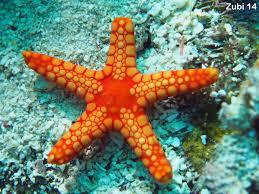
- Echinoderms are marine vertebrates which includes starfish, sea cucumbers, sea urchins etc. they contain about 7000 species and 13,000 extinct species. They are mostly found in habitats such as shallow intertidal areas to abyssal depths. They mostly walk in manners such as crawling or walking through the seafloor but some species use their spines to move. When they are crawling they pump seawater through their internal body canals and the water is used to inflate the feet of the tube and causes them to expand but in some species tube feet are equipped with suckers that grip onto the sea floor. Echinodermata defenses are powerful and well developed. Their defense strategies include spines, toxins which can be delivered through tubed feet.
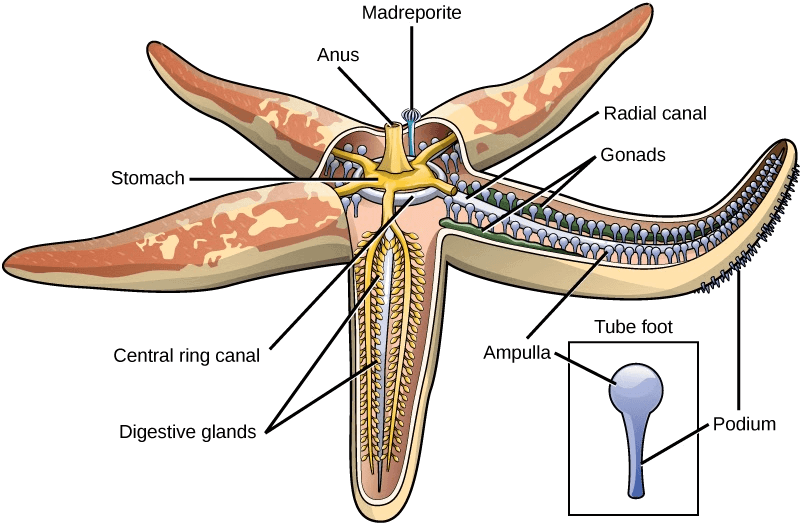
How does starfish locomotion work?
- The underside of the starfish is covered with thousands of tube feet, which helps it to move and tingly grip on the floor. To move each tube, feet swing like a leg lifting up and forward, that attaches itself to the ground at the tip of the feet is the suction cup. The vascular system helps set the hydraulic pressure, which pulls the water. All the tube feet have a swollen structure called an Ampulla. The podium consists of suckers to help starfish to attach to the ground. When the water is pulled inside, it travels from the madreporite through the stone canal, the ring canal, the radial canals, and finally, the lateral canals. This then reaches the Ampulla, where the water is preserved at all times. When the ampulla contracts, it forces the water towards the suckered podium, which results in their extension.once the starfish reaches the position where it wants to relax the ampulla will also relax.This relaxation causes the formation of suction cups. The suction cups forms a vacuum and help to attach the sea star to the surface. After both the steps are completed, the sea star has reached an entirely new location. With these little feet, starfish can move at a speed of 60 feet per hour. This is a slow process but effective.
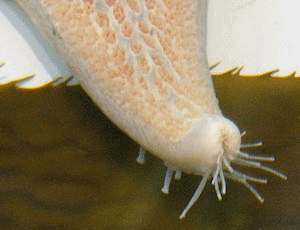
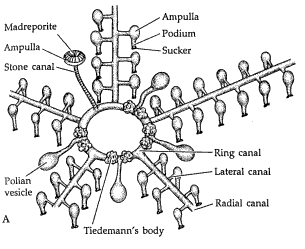
How do starfish defend themselves?
- Some of starfish defense strategies are tube feet, burrowing, and releasing arms. Straight moves by pushing the water with its tube feet. The tubed feet with rippling effects and this helps the starfish to move faster. By moving faster the starfish could get away from its enemy easily. Starfish can dig sand and spray sand at predators eyes and burrow and throw the sand on their bodies when they feel threatened. Starfishes have the power of regeneration. It can drop off the arm that has been grasped by the predator. The starfish can separate its arms from its predator and generate another arm to replace the bitten arm. Starfish can also camouflage with the coral reefs and also developed spiky skins, which are unpleasant for the predator to consume. Also slime texture skin that these starfishes have can eject mucus at predators. These all defenses help starfish against its predators.

How do sea cucumbers move?
- Sea cucumbers can move on the surface through sand or mud using peristaltic movements. Some sea cucumbers contain tubed feet, which helps to creep like starfish. Some sea cucumbers pull themselves with the help of buccal tentacles and others can expand to contract their bodies. Burrowing sea cucumber uses contraction of body muscular walls and moves sand or made out of the way using tentacles.
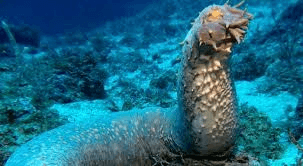
How do sea cucumbers defend themselves?
- Some sea cucumbers have clusters of cuvierian tubules which they will eject as sticky threads from their anus and intertwine and permanently disable the attacker. The respiratory tree in the gut contains these tubules. When startled, these cucumbers may expel the tubules through a tear in the wall of the cloaca. Along with tubules they eject a toxic chemical called holothurin, which could kill the predator. Some sea cucumbers will spew intestine walls and expel their guts and respiratory tree. They are very long and sticky. This substance will get stuck to the predator and the predator will unlike the meal and get away from that place. Sea cucumber can regenerate respiratory tree, guts and intestine wall later.
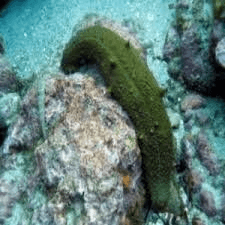
Poriferans
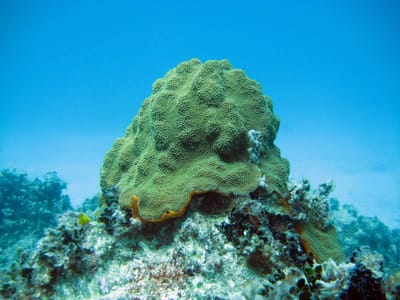
What are Poriferans?
- Poriferans are sea sponges. Although they make up a small part of the animal kingdom, there are still at least 5000 species of poriferans. Sea sponges are actually animals that contain many pores and stick to one spot on the ocean floor. Although an animal, they don’t possess any organs and feed off of phytoplankton, bacteria, in the water. Other than that, how do they survive from predators by just staying in one spot?

How do they move and defend themselves?
- Though the sea sponges stay in one spot, they still have some defense mechanisms. They have an unappealing taste which discourages sea animals to not eat the sea sponge because they contain toxins and they are actually a little bit spiky which doesn’t digest well. However, there are a few predators that still eat the sea sponge. The nudibranch and the hawksbill sea turtle can bypass the toxins of the sea sponge.
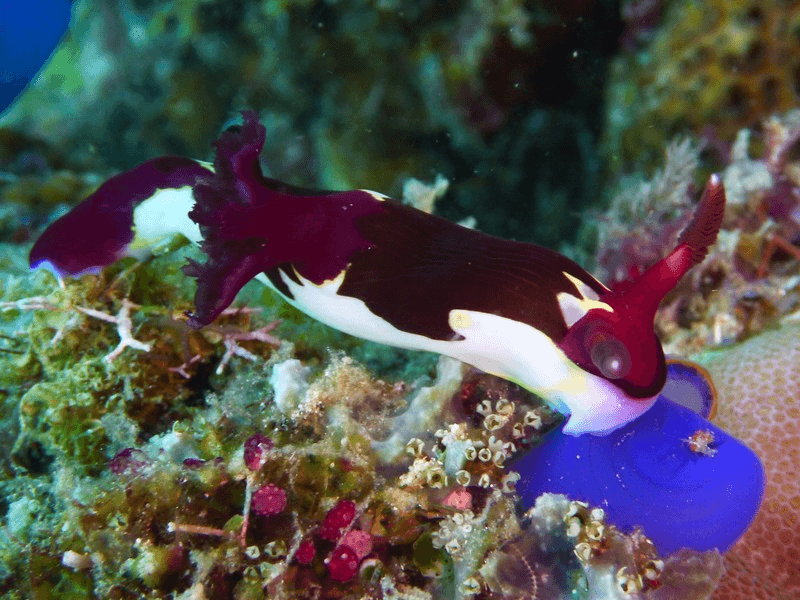
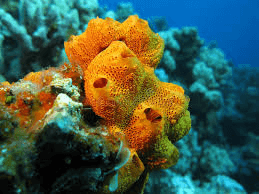
Arthropods and what they are
What are Arthropods?
Learn MoreDefense and movement of insects
Learn MoreDefense and movement of crustaceans
Learn MoreMollusca
What are mollusks and how do their movements and defense work?
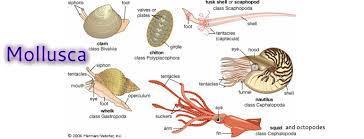
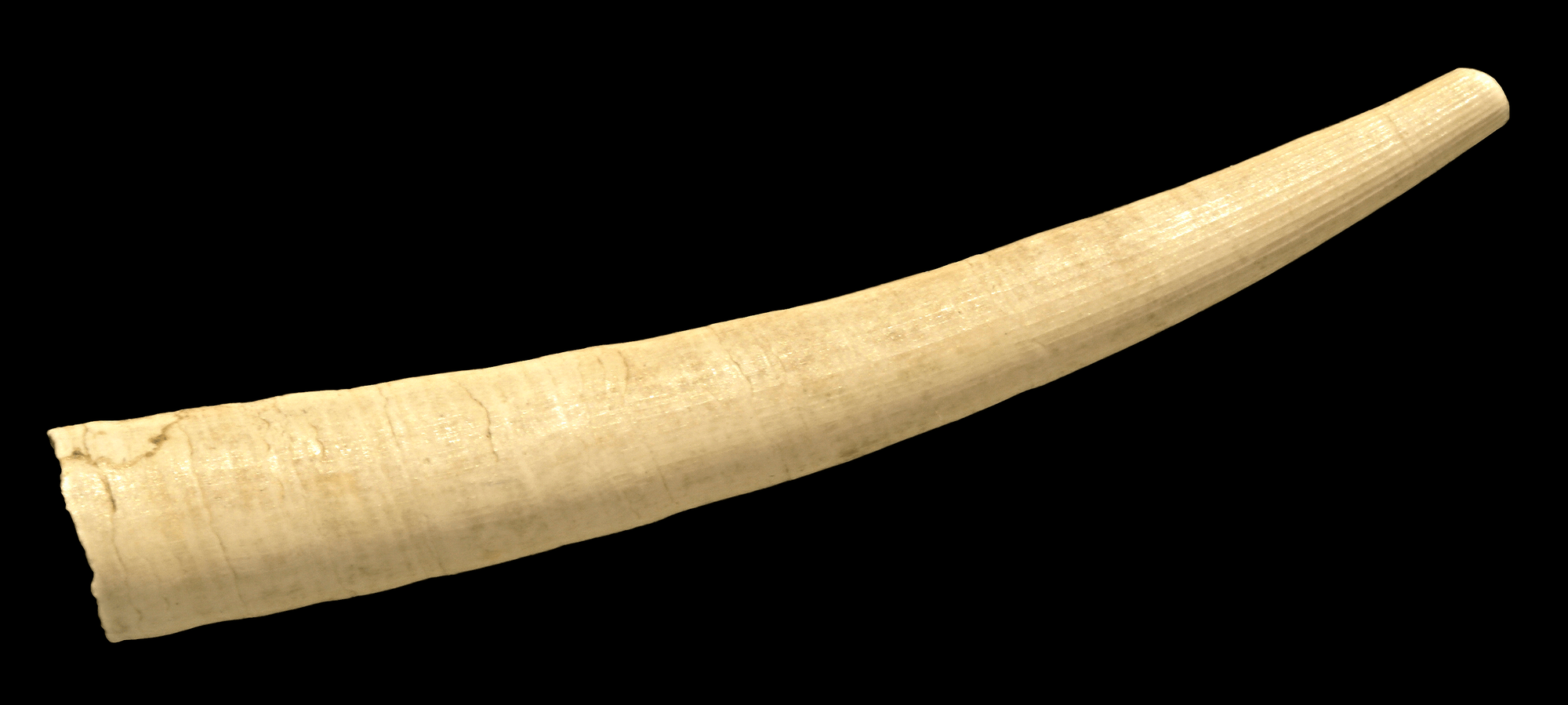
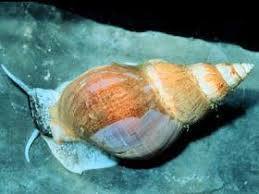
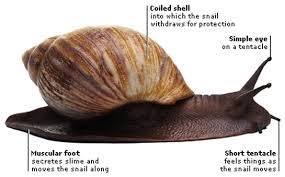
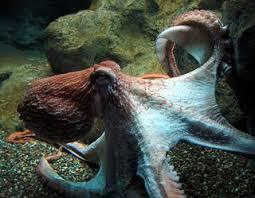
- Mollusks, or mollusca, are an extremely diverse group of animals with close to 100,000 known species and well over 100,000 still undiscovered. Mollusca is the second largest invertebrate phylum (behind arthropods) and the largest marine phylum, comprising 23% of all aquatic life [1]. The classes of mollusca are aplacophora (no shell), monoplacophora (one shell covers the body), polyplacophora (many shells cover the body; chitons), bivalvia (mollusks with a hinged shell), gastropoda (a shell that doesn’t cover the animal’s body), cephalopoda (shell-bearing or reduced shell; squids, octopuses), and scaphopoda (a single conical shell; “tusk shells”) [7].


- All mollusks have soft bodies and have a “head” and “foot” area that allow for ground movement. Snails and bivalves use the foot for travel, although it only permits slow movement. The mucous gland secretes mucus on a surface, both allowing the mollusk to slide on and stick to it, depending on how the mollusk applies pressure. The top recorded speed of a “foot” mollusk is only 0.005 miles per hour. Other mollusks, like squids, octopuses, and cuttlefish, use muscles in their mantle cavities to propel themselves through the expulsion of water. This method is significantly faster than the foot, allowing them to reach bursts of 25 miles per hour.


- Another defining characteristic of a mollusk is the presence of a shell, which can be seen externally on snails and bivalves and internally for cephalopods. Shells provide excellent protection for relatively small predators but don’t hold up against those with strong jaws. Snails and other gastropods can tuck their vulnerable bodies into their shells and can seal themselves in via the operculum, effectively protecting themselves from harm. Other mollusks bury themselves or secrete mucus to lose or deter predators. Some gastropods can store poison to excrete in danger or in the case of cone snails, fire poison-imbued spears at prey or predators. Cephalopods use ink to blind, distract, and ultimately escape from danger. Many cephalopods are also able to alter their coloration and body shape, allowing them to camouflage and confuse predators.

Platyhelminthes
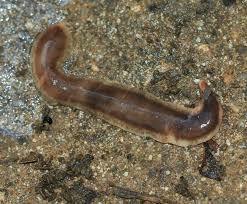

What are Platyhelminthes and how does their locomotion and defense work?
- Platyhelminthes are animals that lack respiratory, circulatory, and skeletal systems. Compared to other phylums, platyhelminthes are extremely primitive. Generalized as flatworms, platyhelminthes are aptly named for their flat bodies. Nearly 80% of all flatworms are parasites, a lifestyle that provides the animals with the necessary nutrients for survival. 25,000 species are extant with organisms falling into one of four classes: turbellaria (planarians), monogenea (parasites), trematoda (flukes), and cestoda (tapeworms).
- Of the four classes of flatworm, turbellaria contains the largest amount of independent species. Turbellarians move via perpetually-vibrating cilia surrounding their body gripping to secreted mucus. Turbellarians have no physical defenses but have camouflage and rapid regeneration, allowing their survival as long as they aren’t swallowed whole.
- Organisms in the class monogenea are exclusively parasites, often living their entire lives in or on a host. The prime method of transportation for monogeneans is on the host (should they need to move around), which is ensured for ectoparasites by adhesive suckers. A cuticle shields them from some damage by predators. However, it is unlikely that monogeneans are killed separately from their host due to their lack of independent movement.
- Trematodes, another type of parasite, also spend their existence with one or two hosts. As it matures, a trematode will kill its primary host (usually a mollusk) and will float in water for several days. When another animal absorbs the parasite through its skin, the worm stops needing to move. Not many defenses are possessed by trematodes, but they are the second most deadly parasite to humans behind malaria.
- The fourth class of trematoda is the cestoda, or tapeworms. Like the other parasitic platyhelminthes, cestodes seldom move on their own; the only time movement is necessary is when a host dies or becomes unusable. As larvae, however, cestodes swim through water in an attempt to be eaten by small crustaceans. Tapeworms live in their host’s intestines, absorbing nutrients through their skin. Cestodes don’t have any notable natural defenses, but due to their reliance on a host, they are protected by whatever defenses the host has.
Annelida
Annelida are phylum that are classified by their soft bodies, metamerism or segmentation, and soft bristles made of chitin called chaetae that surround the body of annelida worms. About 9,000 species of annelida have been identified biologists. All 9,000 species can be classified into three categories: earthworms and freshwater worms (oligochaeta), leeches (hirudinea), and marine dwelling worms (polychaeta). Each category of annelida are comprised of many discrete defensive tactics and movement techniques that best suit their inhabited environment. Despite the differences, each species of annelida have evolved their tactics to best ensure survival long enough to reproduce.
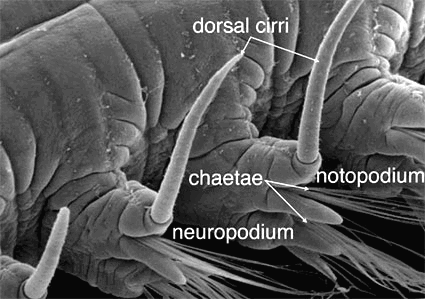
Polychaeta Defense/Movement
Polychaeta possesses a muscular appendages called parapodia surrounding their body. The parapodia are utilized as paddles to assist the polychaeta in swimming, or used for locomotion across the ocean floor and digging out burrows. However, the tiny bristles protruding from the bodies of Polychaeta are not only used for movement. For example, fireworms, marine Polychaeta, utilize their chaetae for defensive reasons. Their fragile and hollow tubes are filled with a deadly and painful toxin, that when touched the brittle tubes break releasing the poison. The toxin released is highly effective, for when in contact with the skin it causes immense pain to the victim. Additionally, many polychaeta have the ability to secrete bright bioluminescent light when threatened. The bright light distracts predators as they make an escape.
Some polychaeta (Alciopid polychaeta) have large complex eyes. Their eyes consist of corneas, irises, lenses, and other structures needed for the high-resolution they have. Additionally, they don’t have a blind spot, as people do, because their retinas are directed towards the light instead of away from light. As a result of their advanced vision, it makes it incredibly hard for predators to catch them, for these small marine worms can see a predator coming from a substantial distance away.
Oligochaeta Defense
Bristles, known as setae, are used as sensing devices that identify vibration in the soil and digging mechanisms. The setae stick to dirt and the earthworm then contracts its body to force itself through the dirt. The defenses of earthworms begin on a microscopic level against the harmful bacteria they encounter. Mucus is excreted out of the worm’s coelomic cavity dorsal pours and serves as an important component in keeping bacteria out of the worm’s coelomic cavity. However, once bacteria enter into the cavity via the dorsal pour, it is met phagocytes, a cell produced within the worm capable of consuming the bacteria, and other humoral factors that easily prevent the spread of bacteria in the coelomic cavity. When it comes to predators oligochaeta basically no defense and are a fairly easy target, however, they are expert burrowers to escape winter or a predator oligochaeta can burrow itself dozen of feet underground in a short amount of time. Worms also have the ability to tell when it is night time and safer to return to the surface. However, these worms are not completely useless when it comes to defenses. When attacked by a predator oligochaeta have the ability to rigorously twist about to escape the clenches of its predator. Its mucus-coated skin creates a slippery seal around the worm that also helps in escaping. Additionally, some worms can give off an odor that will turn off its attacker.
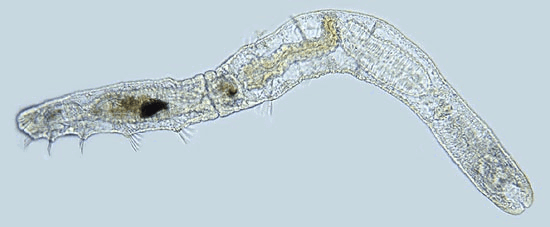
Hirudinea Defense
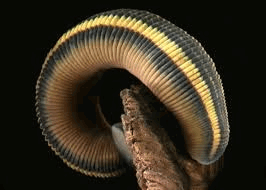
Along the surface Hirudinea (leeches) creep in looping movements of the body using muscle contractions, by attaching their mouth, which acts as a sucker, on the surface, and pulling their body towards their mouth. Aquatic leeches have the ability to freely swim through and up-and-down undulation of the body that propels the leech forwards.
Leeches show the most carnivorous traits out of all other annelida species. For such reason, they show little defense mechanisms other than their ability to quickly swim, the pigmentation of their body allows for optimal camouflage in their swampy freshwater terrains, and the ability to contract their muscles into tight segments to fit into small spaces which acts as an evasive strategy when threatened.

Polychaeta Defense/Movement
Polychaeta possesses a muscular appendages called parapodia surrounding their body. The parapodia are utilized as paddles to assist the polychaeta in swimming, or used for locomotion across the ocean floor and digging out burrows. However, the tiny bristles protruding from the bodies of Polychaeta are not only used for movement. For example, fireworms, marine Polychaeta, utilize their chaetae for defensive reasons. Their fragile and hollow tubes are filled with a deadly and painful toxin, that when touched the brittle tubes break releasing the poison. The toxin released is highly effective, for when in contact with the skin it causes immense pain to the victim. Additionally, many polychaeta have the ability to secrete bright bioluminescent light when threatened. The bright light distracts predators as they make an escape.
Some polychaeta (Alciopid polychaeta) have large complex eyes. Their eyes consist of corneas, irises, lenses, and other structures needed for the high-resolution they have. Additionally, they don’t have a blind spot, as people do, because their retinas are directed towards the light instead of away from light. As a result of their advanced vision, it makes it incredibly hard for predators to catch them, for these small marine worms can see a predator coming from a substantial distance away.
Oligochaeta Defense
Bristles, known as setae, are used as sensing devices that identify vibration in the soil and digging mechanisms. The setae stick to dirt and the earthworm then contracts its body to force itself through the dirt. The defenses of earthworms begin on a microscopic level against the harmful bacteria they encounter. Mucus is excreted out of the worm’s coelomic cavity dorsal pours and serves as an important component in keeping bacteria out of the worm’s coelomic cavity. However, once bacteria enter into the cavity via the dorsal pour, it is met phagocytes, a cell produced within the worm capable of consuming the bacteria, and other humoral factors that easily prevent the spread of bacteria in the coelomic cavity. When it comes to predators oligochaeta basically no defense and are a fairly easy target, however, they are expert burrowers to escape winter or a predator oligochaeta can burrow itself dozen of feet underground in a short amount of time. Worms also have the ability to tell when it is night time and safer to return to the surface. However, these worms are not completely useless when it comes to defenses. When attacked by a predator oligochaeta have the ability to rigorously twist about to escape the clenches of its predator. Its mucus-coated skin creates a slippery seal around the worm that also helps in escaping. Additionally, some worms can give off an odor that will turn off its attacker.

Hirudinea Defense

Along the surface Hirudinea (leeches) creep in looping movements of the body using muscle contractions, by attaching their mouth, which acts as a sucker, on the surface, and pulling their body towards their mouth. Aquatic leeches have the ability to freely swim through and up-and-down undulation of the body that propels the leech forwards.
Leeches show the most carnivorous traits out of all other annelida species. For such reason, they show little defense mechanisms other than their ability to quickly swim, the pigmentation of their body allows for optimal camouflage in their swampy freshwater terrains, and the ability to contract their muscles into tight segments to fit into small spaces which acts as an evasive strategy when threatened.
Cnidarians
What are Cnidarians and how does their locomotion and defense work?
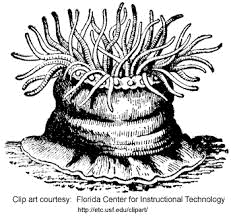
How does locomotion in jellyfish work?
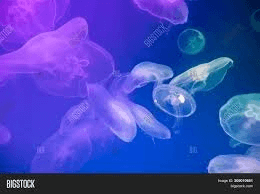
How do hydras' locomotion work?
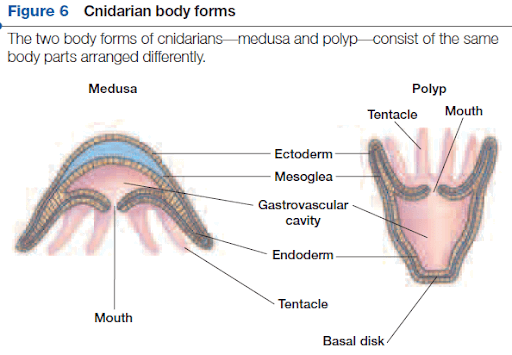
How do jellyfish defend themselves ?
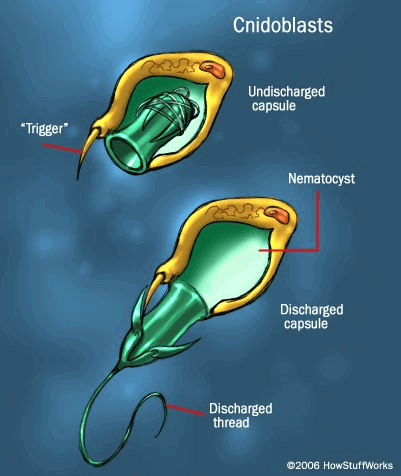
How do hydras defend themselves?
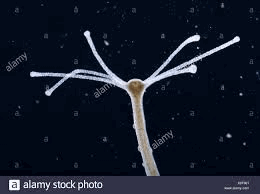
- Cnidaria is a phylum under kingdom Animalia containing over 11,000 species of aquatic animals found both in freshwater and marine environments: they are predominantly marine. Their distinguishing feature is cnidocytes, specialized cells that they use mainly for capturing prey. Their locomotion is pretty fast. Their movement is that they contract their hollow, saucer-shaped bodies called bells to force water out, which propels them forward. When a cnidarian contacts a predator or prey item, the capsule opens and the tubule everts. The tubule may be adhesive, or it may entangle the object. Both types serve to hold food items. A third type of tubule is armed with spines that penetrate predators or prey.

How does locomotion in jellyfish work?
- Jellyfish have a dome shaped body, which is made of solid jellylike substance, deriving their name, which is covered by a very thin layer of living cells as protection and sensory. Positioning, the stomach and the mouth are in the center of the dome-shaped body, and that body is covered by flesh like arms. For the actual movement of the Jellyfish they use a movement of contracting muscles and then relaxing them, propelling them forward in the water. The Jellyfish opens and closes the dome like body, which draws in water and then forces the water out pushing it forwards. Using their sense of touch and temperature they move around to safe spots and with their swarm.

How do hydras' locomotion work?
- Their type of locomotion is known as walking. It may bend its body and perform looping movement like that of a leech. They have two distinct methods for moving – 'looping' and 'somersaulting'. Hydra can move from place to place by looping. During looping, Hydra bends its body from the erect standing position and fixes the tentacles to the substratum by the glutinant nematocysts. It then releases the attachment at the basal disc and moves its free end to a new site. The animal then stands up by making free its tentacles. The other locomotion is somersaulting. Another method of rapid movement in Hydra is somersaulting which is a slight modification of looping locomotion. Hydra fixes itself on the substratum by the hypostomal end and then shifts the attachment of the basal disc. The basal disc is then rotated 180° and is fixed to a new position.

How do jellyfish defend themselves ?
- Jellyfish are carnivores, they use their stinging ability to not only use it to kill prey but to also use it as a defensive mechanism. For a Jellyfish each tentacle is covered by thousands of cell cnidoblasts, which contain nematocysts which have the actual stinging threads. For the process of release to happen it needs to encounter another object, and with that physical contact, pressure inside the nematocysts causes the thread to uncoil. When uncoiled they come out of the threads like very small darts that contain venom, more specifically neurotoxin, which is designed to paralyze prey or whoever is hunting it.

How do hydras defend themselves?
- Hydra tentacles contain barbed, poison containing cnidocytes that they use to stun animals like the water flea, Daphnia, before eating them alive, and to protect themselves from attack by other animals. The linking of opsin to cnidocytes explains how hydra are able to respond to light even though they do not have eyes. This is how hydars are able to protect themselves.

Chordata and Abstraction

What is Chordata and how does their locomotion and defense work?
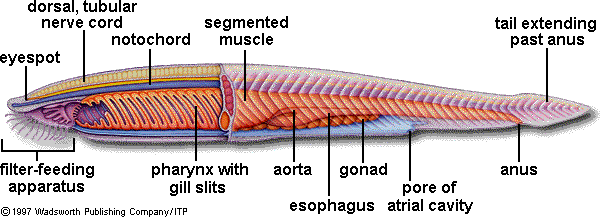
- Chordates are a classification or Phylum of organisms that include organisms that are both vertebrates and invertebrates, but most commonly vertebrates. Chordates are classified by a flexible rod that supports the organism’s back, called a notochord. Chordates can also be invertebrates. There are two subcategories, or subphyla of chordates that include invertebrates. A type of invertebrate chordates is a tunicate, which are, in simplicity, marine chordates with tunics or coats. The other type is called a lancelet which are essentially marine, elongated, filter feeders. Now that that’s out of the way, let’s discuss movement and defense in the phylum of chordates. In the subphylum of lancelets, lancelets move by swimming as both larvae and adults are free swimming. Their notochord provides structural support in the lancelet, and likewise helps the lancelet swim rapidly without shortening or compressing itself. In addition, lancelets have body muscle cells that build up body muscle tissues which surround the lancelet’s organs, keeping everything in place. Hence, lancelets are known to defend themselves by swimming away, but adults can also bury themselves in the sand. In the subphylum of tunicates, tunicates move by swimming and using their notochord as tadpoles to move around. However, once tunicates attach to an object such as rocks, they remain sessile for the most part. Though they are sessile, they can still move by detaching from the object and reattaching. Tunicates are able to defend themselves because of their tunic, which acts as an extra exoskeleton. Last but not least are vertebrates. Vertebrates are classified as any chordate that is also equipped with a backbone. Types of vertebrate chordates include mammals, birds, reptiles, and amphibians. We as humans can be classified as vertebrate chordates. There are a variety of ways vertebrates can move. In mammals and amphibians, the use of legs or limbs to walk, and swimming for amphibians. In fish, swimming is the method of movement, and birds use their wings for flight, as well as legs to move. Along with the various ways to move, there are also multiple ways vertebrates are able to defend themselves. The first is the ability to flee, using the aforementioned method of movement. Vertebrates are able to sense danger by the sensory organs of eyes. Many vertebrates are also able to use their nasal systems to smell any danger. Furthermore, the central nervous system, which is prevalent in a majority of vertebrates, helps organisms to sense danger and quickly act upon danger in order to protect themselves.

Evolution
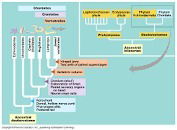
How does Evolution work in Chordates?
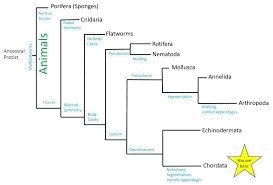
- In chordates, especially vertebrates, evolution is a primary factor in aiding the movement and defense systems of such organisms.For this example, we will zoom into the evolution of humans, and how their evolution over time has helped their ability to move, as well as defending themselves. In human ancestors, it was about 6 million years ago when they first started to become bipedal. Becoming bipedal helped to make human ancestors more mobile. 2 million years later, a majority of human ancestors began to be both bipedal and were able to walk upright, allowing them to take advantage of more open areas. Today, humans of course are fully upright and are able to move by walking or running using two legs. As mentioned before, evolution also has an effect on defense. In humans, the increase in brain size throughout millions of years has helped make us smarter. Just for reference, the average braincase capacity for homo erectus, a human ancestor, was 1029, while homo sapiens of today have an average brain capacity of 1350. Increased brain size has helped us to defend ourselves through the development of advanced weapons and tools, militaries, and societies in general that function to protect and serve us; we have come quite a long way from stone tools. In all, our ability to protect ourselves not only coincides with our anatomy, but likewise in how our evolution has helped us to create numerous ways in which we defend ourselves.

Citations
Biocyclopedia.com. “Class Hirudinea: Leeches.” Class Hirudinea: Leeches | Segmented Worms | The Diversity of Animal Life, biocyclopedia.com/index/general_zoology/class_hirudinea_leeches.php.
Candela, Shawn. “How Do Earthworms Protect Themselves?” Sciencing, 22 Nov. 2019, sciencing.com/do-earthworms-protect-themselves-5166642.html.
“Defense - Roundworms.” Google Sites, sites.google.com/site/roundwormsjfr/defense.
“Echinoderm.” Wikipedia, Wikimedia Foundation, 5 May 2020, en.wikipedia.org/wiki/Echinoderm#Locomotion.
Emily Frost, Hannah Waters. “14 Fun Facts About Marine Bristle Worms.” Smithsonian.com, Smithsonian Institution, 1 July 2015, www.smithsonianmag.com/science-nature/14-fun-facts-about-marine-bristle-worms-180955773/.
“Flatworm.” ScienceDaily, ScienceDaily, www.sciencedaily.com/terms/flatworm.htm.
“Flatworms - Class Turbellaria, Class Monogenea, Class Trematoda, Class Cestoidea.” Class Turbellaria, Class Monogenea, Class Trematoda, Class Cestoidea - Worm, Organs, Head, and Animals - JRank Articles, science.jrank.org/pages/2736/Flatworms.html.
Ghiselin, Michael T. “Cephalochordate.” Encyclopædia Britannica, Encyclopædia Britannica, Inc., 23 Oct. 2008, www.britannica.com/animal/cephalochordate.
How Starfish Move, www.madreporite.com/science/movement.htm.
“Human Evolution Timeline Interactive.” The Smithsonian Institution's Human Origins Program, 16 Sept. 2019, humanorigins.si.edu/evidence/human-evolution-timeline-interactive.
Introduction to the Annelida, ucmp.berkeley.edu/annelida/annelida.html.
Jollie, Malcolm T. “Vertebrate.” Encyclopædia Britannica, Encyclopædia Britannica, Inc., 17 Apr. 2019, www.britannica.com/animal/vertebrate.
Marine Worms, www.mesa.edu.au/marine_worms/marine_worms02a.asp.
Mollusks : Carnegie Museum of Natural History, www.carnegiemnh.org/science/mollusks/predators.html.
“Nematodes - Definition, Examples, Classification and Characteristics.” MicroscopeMaster, www.microscopemaster.com/nematodes.html.
“Nematode Structure and Function.” Nematode Structure and Function - WikiVet English, en.wikivet.net/Nematode_Structure_and_Function.
“Oligochaeta.” Oligochaeta - an Overview | ScienceDirect Topics, www.sciencedirect.com/topics/pharmacology-toxicology-and-pharmaceutical-science/oligochaeta.
Page: Tree of Life Annelida. Segmented Worms: Bristleworms, Ragworms, Earthworms, Leeches and Their Allies. tolweb.org/Annelida/2486.
Rcwebber. “How Do Mollusks Move around the Ocean?: Ask Dr. Universe: Washington State University.” Ask Dr. Universe, 27 Nov. 2018, askdruniverse.wsu.edu/2015/08/10/how-do-mollusks-move-around-the-ocean/.
“Secernentea (Secernentea).” Grzimek's Animal Life Encyclopedia, Encyclopedia.com, 11 May 2020, www.encyclopedia.com/environment/encyclopedias-almanacs-transcripts-and-maps/secernentea-secernenteans.
Smyth, James Desmond. “Flatworm.” Encyclopædia Britannica, Encyclopædia Britannica, Inc., 6 Feb. 2014, www.britannica.com/animal/flatworm.
“Snail Anatomy.” Snail Facts and Information, www.snail-world.com/snail-anatomy/.
Snyderman, Marty. “Echinoderms: Sea Stars, Crinoids, Brittle Stars, Basket Stars, Sea Cucumbers, Sea Urchins and Sand Dollars: Scuba Diving News, Gear, Education: Dive Training Magazine.” Scuba Diving News, Gear, Education | Dive Training Magazine, 15 Aug. 2001, dtmag.com/thelibrary/echinoderms-sea-stars-crinoids-brittle-stars-basket-stars-sea-cucumbers-sea-urchins-and-sand-dollars/.
“Some Worms Recently Evolved the Ability to Regrow a Complete Head.” ScienceDaily, ScienceDaily, 6 Mar. 2019, www.sciencedaily.com/releases/2019/03/190306110623.htm.
The Mollusca, ucmp.berkeley.edu/taxa/inverts/mollusca/mollusca.php.
Tuttle, Russell Howard. “Human Evolution.” Encyclopædia Britannica, Encyclopædia Britannica, Inc., 3 Feb. 2020, www.britannica.com/science/human-evolution.
Candela, Shawn. “How Do Earthworms Protect Themselves?” Sciencing, 22 Nov. 2019, sciencing.com/do-earthworms-protect-themselves-5166642.html.
“Defense - Roundworms.” Google Sites, sites.google.com/site/roundwormsjfr/defense.
“Echinoderm.” Wikipedia, Wikimedia Foundation, 5 May 2020, en.wikipedia.org/wiki/Echinoderm#Locomotion.
Emily Frost, Hannah Waters. “14 Fun Facts About Marine Bristle Worms.” Smithsonian.com, Smithsonian Institution, 1 July 2015, www.smithsonianmag.com/science-nature/14-fun-facts-about-marine-bristle-worms-180955773/.
“Flatworm.” ScienceDaily, ScienceDaily, www.sciencedaily.com/terms/flatworm.htm.
“Flatworms - Class Turbellaria, Class Monogenea, Class Trematoda, Class Cestoidea.” Class Turbellaria, Class Monogenea, Class Trematoda, Class Cestoidea - Worm, Organs, Head, and Animals - JRank Articles, science.jrank.org/pages/2736/Flatworms.html.
Ghiselin, Michael T. “Cephalochordate.” Encyclopædia Britannica, Encyclopædia Britannica, Inc., 23 Oct. 2008, www.britannica.com/animal/cephalochordate.
How Starfish Move, www.madreporite.com/science/movement.htm.
“Human Evolution Timeline Interactive.” The Smithsonian Institution's Human Origins Program, 16 Sept. 2019, humanorigins.si.edu/evidence/human-evolution-timeline-interactive.
Introduction to the Annelida, ucmp.berkeley.edu/annelida/annelida.html.
Jollie, Malcolm T. “Vertebrate.” Encyclopædia Britannica, Encyclopædia Britannica, Inc., 17 Apr. 2019, www.britannica.com/animal/vertebrate.
Marine Worms, www.mesa.edu.au/marine_worms/marine_worms02a.asp.
Mollusks : Carnegie Museum of Natural History, www.carnegiemnh.org/science/mollusks/predators.html.
“Nematodes - Definition, Examples, Classification and Characteristics.” MicroscopeMaster, www.microscopemaster.com/nematodes.html.
“Nematode Structure and Function.” Nematode Structure and Function - WikiVet English, en.wikivet.net/Nematode_Structure_and_Function.
“Oligochaeta.” Oligochaeta - an Overview | ScienceDirect Topics, www.sciencedirect.com/topics/pharmacology-toxicology-and-pharmaceutical-science/oligochaeta.
Page: Tree of Life Annelida. Segmented Worms: Bristleworms, Ragworms, Earthworms, Leeches and Their Allies. tolweb.org/Annelida/2486.
Rcwebber. “How Do Mollusks Move around the Ocean?: Ask Dr. Universe: Washington State University.” Ask Dr. Universe, 27 Nov. 2018, askdruniverse.wsu.edu/2015/08/10/how-do-mollusks-move-around-the-ocean/.
“Secernentea (Secernentea).” Grzimek's Animal Life Encyclopedia, Encyclopedia.com, 11 May 2020, www.encyclopedia.com/environment/encyclopedias-almanacs-transcripts-and-maps/secernentea-secernenteans.
Smyth, James Desmond. “Flatworm.” Encyclopædia Britannica, Encyclopædia Britannica, Inc., 6 Feb. 2014, www.britannica.com/animal/flatworm.
“Snail Anatomy.” Snail Facts and Information, www.snail-world.com/snail-anatomy/.
Snyderman, Marty. “Echinoderms: Sea Stars, Crinoids, Brittle Stars, Basket Stars, Sea Cucumbers, Sea Urchins and Sand Dollars: Scuba Diving News, Gear, Education: Dive Training Magazine.” Scuba Diving News, Gear, Education | Dive Training Magazine, 15 Aug. 2001, dtmag.com/thelibrary/echinoderms-sea-stars-crinoids-brittle-stars-basket-stars-sea-cucumbers-sea-urchins-and-sand-dollars/.
“Some Worms Recently Evolved the Ability to Regrow a Complete Head.” ScienceDaily, ScienceDaily, 6 Mar. 2019, www.sciencedaily.com/releases/2019/03/190306110623.htm.
The Mollusca, ucmp.berkeley.edu/taxa/inverts/mollusca/mollusca.php.
Tuttle, Russell Howard. “Human Evolution.” Encyclopædia Britannica, Encyclopædia Britannica, Inc., 3 Feb. 2020, www.britannica.com/science/human-evolution.



